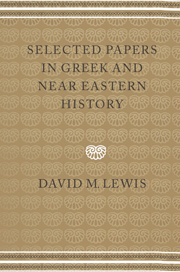Book contents
- Frontmatter
- Contents
- List of plates
- Preface
- Systems of reference
- GENERAL
- ATHENIAN
- 9 Public property in the city
- 10 Cleisthenes and Attica
- 11 Review of J. S. Traill, The Political Organization of Attica
- 12 Review of P. Siewert, Die Trittyen Attikas und die Heeresreform des Kleisthenes
- 13 The Kerameikos ostraka
- 14 Megakles and Eretria
- 15 The Athenian Coinage Decree
- 16 Athena's robe
- 17 The treaties with Leontini and Rhegion
- 18 Entrenchment-clauses in Attic decrees
- 19 Apollo Delios
- 20 After the profanation of the Mysteries
- 21 Aristophanes and politics
- 22 Who was Lysistrata?
- 23 A note on IG i2114 [= i3105]
- 24 The epigraphical evidence for the end of the Thirty
- 25 The financial offices of Eubulus and Lycurgus
- 26 The dating of Demosthenes' speeches
- 27 Law on the Lesser Panathenaia
- 28 The Athenian Rationes Centesimarum
- 29 The chronology of the Athenian New Style Coinage
- 30 Review of M. Thompson, The New Style Silver Coinage of Athens
- NEAR EASTERN
- Bibliography
- Publications of David M. Lewis
- Indexes
10 - Cleisthenes and Attica
Published online by Cambridge University Press: 15 January 2010
- Frontmatter
- Contents
- List of plates
- Preface
- Systems of reference
- GENERAL
- ATHENIAN
- 9 Public property in the city
- 10 Cleisthenes and Attica
- 11 Review of J. S. Traill, The Political Organization of Attica
- 12 Review of P. Siewert, Die Trittyen Attikas und die Heeresreform des Kleisthenes
- 13 The Kerameikos ostraka
- 14 Megakles and Eretria
- 15 The Athenian Coinage Decree
- 16 Athena's robe
- 17 The treaties with Leontini and Rhegion
- 18 Entrenchment-clauses in Attic decrees
- 19 Apollo Delios
- 20 After the profanation of the Mysteries
- 21 Aristophanes and politics
- 22 Who was Lysistrata?
- 23 A note on IG i2114 [= i3105]
- 24 The epigraphical evidence for the end of the Thirty
- 25 The financial offices of Eubulus and Lycurgus
- 26 The dating of Demosthenes' speeches
- 27 Law on the Lesser Panathenaia
- 28 The Athenian Rationes Centesimarum
- 29 The chronology of the Athenian New Style Coinage
- 30 Review of M. Thompson, The New Style Silver Coinage of Athens
- NEAR EASTERN
- Bibliography
- Publications of David M. Lewis
- Indexes
Summary
There has been much recent work on Cleisthenes. The justification for yet another article lies, I hope, in its different approach, from the land of Attica itself and the framework which Cleisthenes gave it. I hope also that this difference of approach will excuse what may seem a somewhat cavalier attitude to my immediate predecessors, whose arguments will seldom appear, although I have read them with attention and profit. The argument of this article proceeds largely from survivals, and leads to the paradox that we can understand Cleisthenes' work best in the places where he failed. These failures, however, give us clearer light not only on his aims, but on the woven texture of tradition and innovation which is formed by the life of classical Athens.
REGIONAL PARTIES IN SIXTH-CENTURY ATHENS
Let us begin by sketching our evidence for regional divisions in Athenian politics before Cleisthenes' reforms. The parties of the 560s have regional names, acquired, we are told, from the places where they farmed. We should emphasise that parties may include members from outside the original area of the nucleus. When Peisistratus waited at Marathon in 546, supporters came to him from Athens itself as well as from the country–villages. This should also act as a warning against any easy assignment of single economic or even constitutional motives to a party. The party may be a complex of driving–forces held together by its leader; such a complex is in fact sketched for Peisistratus' party by Aristotle. However, even with these qualifications in mind, it is legitimate to look for the nuclei.
- Type
- Chapter
- Information
- Selected Papers in Greek and Near Eastern History , pp. 77 - 98Publisher: Cambridge University PressPrint publication year: 1997
- 1
- Cited by



